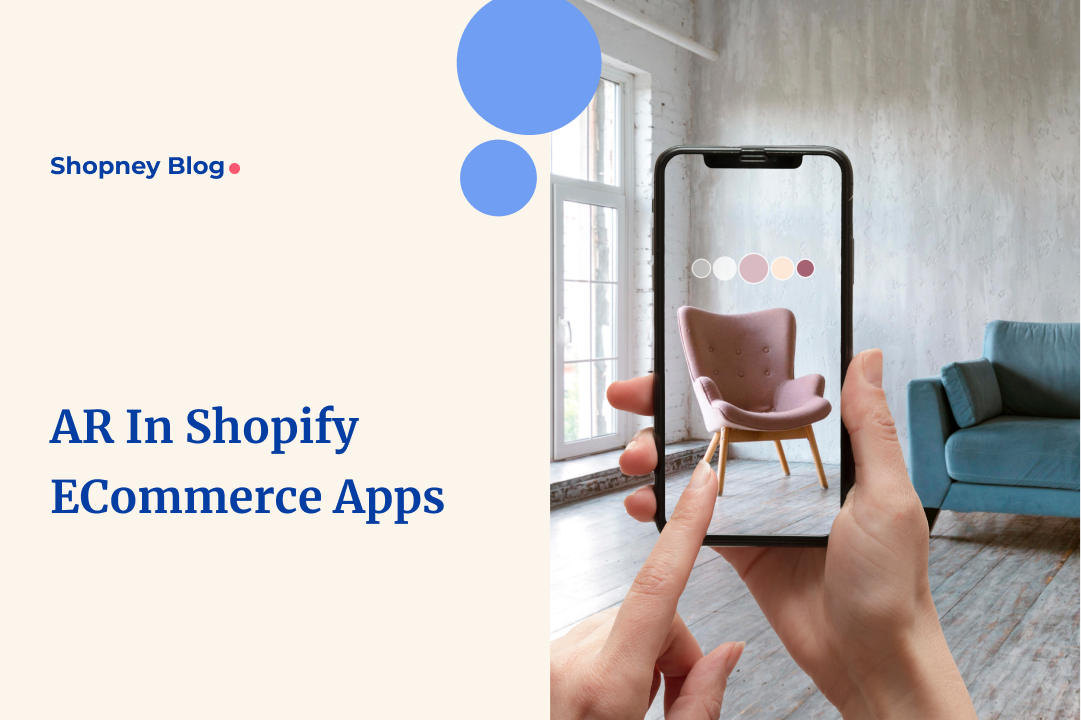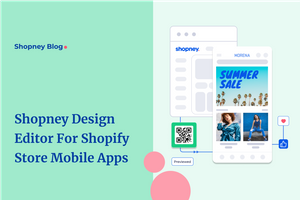
As the world increasingly turns towards online shopping and mCommerce, technology is constantly evolving to find solutions that make the experience as pleasurable and engaging as offline, traditional retail.
One way brands and app developers are captivating and retaining customers is through Augmented Reality (AR).
It’s being touted as a game changer for immersive shopping experiences.
Is it all hyper? Or can AR truly bridge the gap between online browsing and physical shopping?
Let’s dive in.
AR statistics you should know
In a study, about how augmented reality (AR) can influence people's decisions when they shop on their phones, and if it makes them feel more like they are shopping from a brick-and-mortar store, they found out that:
- AR leads to people placing a higher value on a product, both in terms of usefulness, and enjoyment
- it felt more interactive, especially if the feature was easy to use
Here are a few more statistics about AR that show it’s rising use in eCommerce:
- In 2024, more than 1.3b users will be using Augmented Reality devices
- More than 32% of shoppers are already using AR to shop
- 55% of consumers said that AR makes shopping more fun and engaging
- 45% said it saves them time
- 77% said they wanted to use AR to see the product in different colors or styles
- 71% said they’d shop more frequently if AR features were available
The role of AR in mobile shopping
Let’s look into different ways AR can enhance the shopping experience for your mobile app users:
1. Engaging, intuitive shopping experiences
In the previous section, we mentioned a study that found out that AR brings in much needed interaction between the brand and the shopper, and that enriches their shopping experience.
When a product's value increases in the eyes of a consumer, they are more likely to trust your brand and decide to shop from your app.
It’s no longer a screen just staring back; the shopper has to carry out a task, depending on the app’s AR feature, which leaves a memorable impression, less likely to be lost from memory, even if a distraction pops up.
2. More orders, less returns
A survey found that 30% of online products have a return rate, compared to 8.89% for items bought in physical stores.
Returns are costly for D2C brands, as they also have to pay more for quality checks and warehousing.
But online users tend to be skeptical, because photographs can easily be manipulated, and anything can be ‘made to look good.’
As a result, when they get the product, it’s not how they’d imagined it would be, and that disappointment quickly leads to initiating a return.
But with AR, a consumer can more concretely envision how a product will look in their environment.
This reduces the gap between perceived value and actual value, leading to less orders getting returned.
3. Virtual try-on sessions
In an interview, David Hockney, a world-renowned artist, said that the camera doesn’t do well envisioning surfaces, but human beings see ‘space’.
When you shop online, you don’t get the feel of the texture of a fabric or the polished wood of furniture you want to buy.
That’s why many shoppers still prefer to shop offline, more than how a product looks, and instead ,how it looks on them, or in their space.
Helping consumers envision life with your brand’s product is powerful and can cement its place in their daily lives without friction.
By offering AR try-on features on your app, your consumer can try on your shoes literally by looking down to their feet.
Or see how an outfit from your catalog fits on their frame before they buy..
Makeup, accessories, eyewear, wall paint shades; all of these retail industries can find AR incredibly useful to increase a consumer's faith in a product before they buy.
This too, bridges the gap between offline and online, which is critical for mCommerce to thrive.
4. Interactive User Manuals
One of the friction points in online shopping is the fear about how easy it will be to use the product to get the result your brand is promising them.
To tackle this, you can fill the page with detailed user instructions, but that is likely to get ignored, or misunderstood.
Even including video tutorials has a downside; it tends to take a consumer out of the app, and once they’ve left, they will find a hundred different shiny things online to keep them distracted and not return.
In such cases, you can show how to use products with a learning curve through AR.
When you can guide your potential customers quickly and vicerally, how easy or helpful your product it, they are more likely to purchase it.
5. Delivering personalized experiences
Most apps, as the brand expands, need to factor in localization, so as to reach more effectively different groups of people.
Take for example, Google Translates AR mode, which besides transforming traveling, has also brought in easy and instant translations of their favourite app's content.
When customers can access and interact with your app in the language of their preference, you increase customer trust and, consequently, orders.
We all know by now that personalization in their shopping experience is key, and AR can help your brand be known across a global audience.
Examples of shopping apps that use AR well
1. All Birds
This famous sneaker brand’s app has an AR filter that shows how their pair will look on your feet, even as you walk and move!
Just like an offline, physical store.
Many of their customers have written how that feature is convenient and helped them place an order with faith.
This also increases anticipation for the sneaker, because the customer knows how good it looks and can’t wait to wear it.
2. Sephora Virtual Artist
Skincare and makeup brands usually have bigger product catalogs because of the sheer diversity of skin tones.
That is why, in an offline store, you try out variants on your skin, look at the mirror, and then leave the guesswork out. You know when a product looks good on you.
Sephora wanted to bridge this gap, and they used AR to do so.
With their try-on feature, app users could experiment with different looks, from lipstick shades to eye shadow palettes, directly on a live image captured by the mobile’s camera.
This personalized experience helped users make more informed decisions about whether they will truly enjoy a product once it is delivered.
3. Nike Fit
Nike Fit’s AR feature added another dimension to virtual try-on sessions- recommendations.
It uses AR to accurately measure the user's feet, and recommend shoe variants based on it.
This increases trust in the brand, as sizing and fitting errors are reduced.
As a result, their users would order a pair of shoes because they know they’ll be the right fit.
This also reduces the chances of returns!
4. Warby Parker
Like makeup, eye accessory choices are also very personal. The right frame enhances the face shape and adds a certain flair.
Warby Parker used AR to provide a realistic representation of how different styles of glasses would look on an interested user's face.
This led to confident purchases from their app users.
5. Home Depot
Furniture can be tricky to buy through an app since photographs can confuse shoppers about its size and shape, leading to poor purchase decisions.
Nothing is more irritating for someone setting up their place than to get a sofa or a table delivered that doesn’t fit with the rest of their furniture!
Home Depot’s AR feature took care of this friction point, by helping customers visualize how an item can look within their actual space, increasing their app orders.
6. Zara AR
Fast-fashion retailer, Zara launched an AR campaign, with a twist, different from all the examples we’ve mentioned above.
In this campaign, they took down their mannequins and left the display windows bare, inciting curiosity.
With their AR feature, users would download the Zara mobile app, point it at the window, and watch their models posing, moving and speaking with their latest collection!
This usage of AR brought in a lot of eyeballs and was a unique way of making shopping from the brand more interactive.
7. Target
With the pandemic ushering in a strong shift to online shopping, Target brought in its AR feature to help its customers visualize furniture and decor items in their store, and how it would look in their space.
This way, they won’t lose their existing clientele who shopped offline and retained them via their app since they could make intuitive and trust-based decisions while placing an order.
8. Loreal Paris
L'Oréal Paris’ AR feature allows a user to try on their makeup virtually, so they could see how it wold look on their skin.
After experimenting with different colors and styles, which also made shopping from their app fun, they confidently brought the product they liked.
9. Ikea
Ikea’s furniture preview AR feature helps users know, not just think or hope, how their furniture would look in their homes.
With visual confirmation on a product’s size, shape and how it would fit and match their existing furniture, users purchased with more confidence, and lowered returns.
10. Gucci
Even luxury brands like Gucci have hopped onto the AR bandwagon. This makes sense, as their products have a higher average order value.
Their customers need more visual confirmation before investing their money, and AR helped to increase their trust in their choice.
With their AR feature, app users could see how their shoes would fit on them, and how it would look from different angles.
Wrapping up
At Shopney, we understand how powerful AR can be for mCommerce and mobile shopping apps.
That’s why brands can leverage Shopify’s built-in AR feature as they build their mobile apps with our drag-and-drop builder, seamlessly integrating 3D product models.
When your customers can see your products in their unique environments, they can have more informed and engaging shopping experience through your app.
Ready to embrace AR in your mobile app? Reach out to us here!



